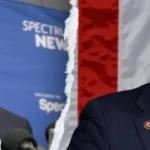President Trump linked his tariff plan to a promise of $2,000 payments per person, excluding high earners, but did not provide details on eligibility, timing, or implementation. He claimed tariffs could boost revenue, domestic investment, and help pay down the national debt. On social media, he criticized critics of tariffs, framing them as a key part of national strength.
Trump Pledges $2,000 Tariff ‘Dividend’ to Americans, but Experts Question the Math
President Donald Trump has promised to give most Americans a $2,000 payment from what he claims are “trillions of dollars” in tariff revenue his administration has collected. However, policy experts and even his own Treasury Secretary have cast doubt on the proposal, citing questionable math, conflicting priorities, and a lack of concrete plans.
In a recent Truth Social post, Trump declared, “People that are against Tariffs are FOOLS! We are taking in Trillions of Dollars and will soon begin paying down our ENORMOUS DEBT… A dividend of at least $2000 a person (not including high income people!) will be paid to everyone.”
Despite the pledge, the administration has published no official plans for such a dividend. Details have been limited to Trump’s social media posts, which state that “low and middle income USA Citizens” would be the first to receive payments. The posts did not define “high income” or specify if children would be eligible.
The Financial Reality
Experts immediately questioned the feasibility of the plan, pointing out that tariff revenue is far below the “trillions” Trump claims.
-
Revenue Collected: Through the end of October, the federal government collected $309.2 billion in tariff revenue for the year.
-
Estimated Cost: Erica York of the Tax Foundation estimated a $2,000 payment to Americans earning under $100,000 would cost nearly $300 billion, a figure that would rise if children qualified. The Committee for a Responsible Federal Budget projected the total cost could be as high as $600 billion.
Based on these figures, the proposed dividend could cost as much or more than the entire amount of tariff revenue collected so far.
Conflicting Promises for Tariff Revenue
The proposal also contradicts previous statements from the Trump administration, which had already designated the tariff revenue for other purposes. Both Trump and Treasury Secretary Scott Bessent have repeatedly stated that the revenue would be used to pay for tax cuts and to reduce the national debt.
“We have so much money coming in, we’re thinking about a little rebate but the big thing we want to do is pay down debt,” Trump told reporters in July.
When asked about the dividend, Bessent suggested it “could come in lots of forms,” including previously announced tax cut proposals, such as making tips, overtime, and Social Security tax-free. Analysts noted that rebranding an existing promise as a new dividend is a stretch.
Current Costs and Political Hurdles
Ironically, independent estimates show that Trump’s tariffs are already costing the average American household between $1,600 and $2,600 per year in higher prices. Given the similar figures, York suggested it would be more efficient to simply remove the tariffs.
Furthermore, the proposal faces significant legal and political obstacles:
-
Supreme Court Challenge: The U.S. Supreme Court is currently weighing the legality of Trump’s tariff policy. A ruling against the administration could eliminate much of the future revenue needed for any dividend.
-
Congressional Approval: According to Joseph Rosenberg of the Tax Policy Center, a direct payment would require approval from Congress. Lawmakers have already declined to act on a similar proposal from Sen. Josh Hawley, R-Mo., which would have provided a $600 tariff rebate.





